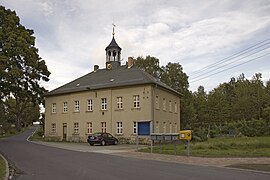Heavenly Lord Treasure Trove
| Heavenly Lord Treasure Trove | |||
|---|---|---|---|
| General information about the mine | |||
| New hut house of the Himmelsfürst mine, 2009 | |||
| other names | Heavenly Lord Pit | ||
| Mining technology | Civil engineering | ||
| Rare minerals | Argyrodit, Freieslebenit, Jordisit, Xanthocon | ||
| Information about the mining company | |||
| Employees | 1770 (1886) | ||
| Start of operation | 1572 | ||
| End of operation | 09/30/1969 | ||
| Successor use | Electric power generation | ||
| Funded raw materials | |||
| Degradation of | Silver, lead, zinc | ||
| Geographical location | |||
| Coordinates | 50 ° 51 '28.3 " N , 13 ° 17' 56.2" E | ||
|
|||
| Location | Sky prince | ||
| local community | Brand-Erbisdorf | ||
| District ( NUTS3 ) | Central Saxony | ||
| country | Free State of Saxony | ||
| Country | Germany | ||
| District | Freiberg district | ||
The silver mine Himmelsfürst Fundgrube near Brand-Erbisdorf in the Ore Mountains was together with the Himmelfahrt Fundgrube the most profitable and best-known Saxon ore mine in the 19th century . The mine was known for its rich silver . The dawn of August 12, 1749 alone yielded 68 kg of the precious metal . From 1573 to 1885 Himmelsfürst produced almost uninterrupted yield . A total of 650 tons of silver were mined.
The Himmelsfürst Fundgrube and the Himmelsfürst settlement of the same name are located in the southern corridor of St. Michaelis , which has been a district of Brand-Erbisdorf in the Saxon district of Central Saxony since October 1st, 1993 .
history
1572 to 1913
The Himmelsfürst mine in the southwest of the Freiberg district , west of the town of Brand-Erbisdorf, was awarded in 1572 . In the course of time it was drained through various Stölln , such as the Weißtaubner Stolln , the Brandstolln , the Thelersberger Stolln and from 1882 the Rothschönberger Stolln . Even before 1800, the mine operational engineering below the Stoll sole . The water was lifted onto the bottom of the tunnel with an artificial tool in the Himmelsfürster Kunstschacht .
Due to the good earnings situation over the years, Himmelsfürst was able to buy up the neighboring mines. This, together with the 18th and 19th centuries new wells drilled shafts rose Himmelsfürst on to a large company. In 1886, 1770 men were employed at the mine. In the 19th century, the mining operation was modernized and a number of water column machines for dewatering as well as steam machines for extraction were purchased, for example on the trust-in-God shaft , the Glückaufschacht and the Frankenschacht. After the silver price fell , Himmelsfürst was nationalized in 1886, like many other mines, and closed in 1913.
1946 to 1969
After the Second World War, SAG Wismut carried out exploration work on uranium ore in the Himmelsfürst mine, as in all Ore Mountain mines , but without any result. Then it was handed over to the VEB Bergbau- und Hüttenkombinat "Albert Funk" in Freiberg, which started the extraction of lead zinc candles, which were initially transported by truck to the central processing facility at Davidschacht . Later Himmelsfürst was connected to the Davidschacht by a crosscutting . The mine was continuously modernized, u. a. the Glückaufschacht received a new headframe and an electrically driven Koep machine .
Preserved facilities
- Wassergöpelhaus from Dorothea Treibeschacht from 1781.
- Hut house Vestesburg
- Old hat house
- Himmelsfürst treasure trove new hut house from 1858.
- Prayer house
- medium wash
- Powder house at the old hat house
- Steam pounding mill (building only)
- Himmelsfürst stop on the Brand-Erbisdorf – Langenau line
- Hut house hope of God's treasure trove
- Heavenly Halde
- Frankenschachter hothouse
Himmelsfürst Fundgrube as a type locality
The Himmelsfürst Treasure Trove was not only a rich ore deposit, but also a well-known site for many and sometimes rare minerals . It is also considered a type locality (first location) for the silver minerals Free Lifeite (1783, 1817), Xanthocon (1797) and Argyrodite (1886) as well as for the molybdenum sulfide Jordisite (1909). Argyrodit is also the first chemical compound in which Clemens Winkler discovered the element germanium .
In total, over 90 minerals and varieties have been found in the Himmelsfürst Fundgrube so far (as of 2015) such as the other silver minerals acanthite and chlorargyrite , the lead minerals galena and cerussite , the zinc minerals sphalerite and wurtzite as well as the gemstones malachite , opal and rhodochrosite .
(→ see also: Freiberg Gangerz deposit )
Individual evidence
- ^ Districts of the mountain town of Brand-Erbisdorf
- ↑ Mineralienatlas : Type locality Grube Himmelsfürst, description of the place of discovery and list of mineral finds
literature
- Matthias Dietrich: The Himmelsfürster silver plate from 1749. In: Proceedings 17th International Mining & Mining History Workshop. Freiberg 2014, ISBN 978-3-86948-364-1 , pp. 54-62.
- Thomas Maruschke, Matthias Dietrich: The Himmelsfürst mine, Saxony's richest silver mine (= Heimatarchiv series ). 1st edition. Sutton, Brand-Erbisdorf 2009, ISBN 978-3-86680-495-1 .
- EW Neubert: Contribution to the history of the Himmelsfürst mine treasure trove behind Erbisdorf. In: Yearbook for mining and metallurgy in the Kingdom of Saxony 1880. Freiberg, pp. 27–36. (Digitized version)
- EW Neubert: About gait conditions at Himmelsfürst Fundgrube behind Erbisdorf. In: Yearbook for mining and metallurgy in the Kingdom of Saxony 1881. Freiberg, pp. 50–66. (Digitized version)
- Otfried Wagenbreth : The Freiberg mining. Technical monuments and history . Ed .: Eberhard Wächtler . 2nd Edition. German publishing house for basic industry, Leipzig 1988, ISBN 3-342-00117-8 .


